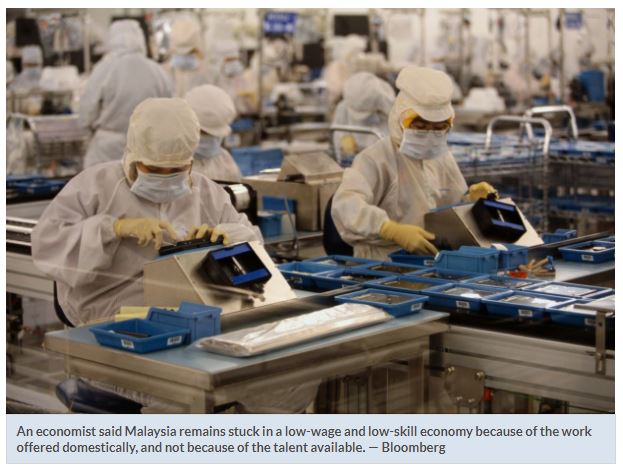Malaysia: Labour market’s structural issues remain
PETALING JAYA: The worst may be over for the Malaysian labour market, but experts say structural issues are still abundant.
In fact, while more Malaysians are being hired, the national unemployment rate for 2022 was recorded at 3.6%, considerably above the 2019 pre-pandemic level of 3.3%.
Economist Geoffrey Williams told StarBiz that the local labour market is not improving “as much as people think”.
“Unemployment is low because of the definition which counts anyone who works just one hour in the previous week as being employed.
“Also, in the absence of meaningful social protection, people have to take whatever comes their way, and so actually, they are basically unemployed,” he said yesterday.
The economics professor at the Malaysia University of Science and Technology (MUST) pointed out that nearly two million people are suffering from structural under-employment.
In addition, there are about 7.2 million people outside of the labour force, including 900,000 graduates. “Taken together, this is around 10 million people of working age under-utilised or not earning regular living wage level incomes,” he said.
According to Williams, average wages have not recovered above 2019 levels and the extension of the minimum wage exemption, which could cover 1.8 million people, will also hit incomes.
“These problems are extremely serious because the social costs of unemployment are very heavy and would hold down incomes and life chances.
“This is a problem for specific regions, social groups such as women and youths and is inter-generational.
“From an economics perspective, this is massive unused resources, especially for graduates and people with skills. It is causing significant problems and holding back growth,” he said.
The economist highlighted the fact that Malaysia remains stuck in a low-wage and low-skill economy because of the work offered domestically, and not because of the talent available.
In a thematic report issued by MIDF Research yesterday, it was also pointed out that structural issues remained in the domestic labour market.
The report, co-authored by Zafri Zulkeffeli and Mu’izz Morhalim, also noted that Malaysia’s unemployment rate will only return to the pre-pandemic level of 3.3% in 2024.
According to MIDF Research, the employment share of Malaysia’s manufacturing sector has fallen to a record-low level last year. In 2022, the sector’s contribution to total employment declined to 14.5%.
Despite the booming external trade sector during the pandemic years, the manufacturing sector’s employment rate rose slower than total employment growth.
“On a positive note, the average monthly wage level stayed on an uptrend from RM2,765 in 2016 to RM3,420 in 2022. However, the wage growth remained tepid post-pandemic at 2% per annum,” stated MIDF Research.
Between 2016 and 2019, the average wage growth was about 6%.
“The economic recovery for the manufacturing sector was quite uneven, given that more than 40 industries registered negative wage growth in 2022,” it said.
Similar to MUST’s Williams, MIDF Research also raised concerns about the prevalent skills mismatch in the country. It said skill-related under-employment stayed above the pre-pandemic level, at 11.9%, in 2022.
However, it is noteworthy that the underemployment was slightly lower than the record-high level of 12.4% in 2020.
The research house attributed the high under-employment level to two main reasons, namely, the misalignment between the skill-sets provided by educational institutions and what’s required in the labour market, or the fact that the economy does not create jobs that resemble the skills-set of certain individuals.
Meanwhile, MIDF Research also mentioned that the youth unemployment rate in Malaysia continued on a double-digit rate.
“In line with the stronger-than-expected economic performance in 2022, the jobless rate across all age groups improved. However, these jobless rates were still stubbornly above 2019 levels. Malaysia’s youth jobless rate remained at a double-digit rate, 10.7%, in 2022,” it said.
In 2019, the youth unemployment rate was 9.9%.
“Looking ahead, we are optimistic that the overall jobless rate will descend further this year amid the steady domestic economic expansion rate.
“We believe some of the age group unemployment rate will recede to pre-pandemic levels in 2022,” it added.
Contrary to popular opinion among employees, MUST’s Williams stressed that there was no shortage of people or skills in Malaysia. He said the mismatch was because skills were too high relative to the jobs offered.
Malaysians are reluctant to take many jobs because the salaries are too low, often below living wages and even minimum wages are not paid. Terms and conditions of the jobs are also very poor, he said.
“Enforcement of rights for workers in the labour court and industrial court is too long and haphazard.
“There are basically no labour rights in Malaysia, especially for those on low salaries and of course foreign workers have no feasible protection at all. These issues are because of bad management.
“The government must review the employment laws again, impose the minimum wage, encourage flexible working with tax incentives and encourage multiple income options,” he added.
Looking ahead, Williams said the views of the employers organisations must be opposed to rebalance the labour market and stop outdated human resource management ideas dominating the debate.
Source: https://www.thestar.com.my/business/business-news/2023/02/16/labour-markets-structural-issues-remain


 English
English




